Management Accounting: Costing, Budgeting, and Financial Analysis
VerifiedAdded on 2023/01/13
|11
|2428
|76
Report
AI Summary
This report provides a comprehensive analysis of management accounting principles, focusing on their application within Rowlinson Knitwear. It begins with an introduction to management accounting, detailing its role in managerial decision-making and the essential requirements of various management accounting systems, such as job costing and inventory management. The report then explores different methods of management accounting reporting, including budget reports, account receivable ageing reports, and performance reports. A significant portion is dedicated to the calculation of costs using marginal and absorption costing methods, providing income statements for each method. Furthermore, the report examines the advantages and disadvantages of different planning tools for budgetary control, such as fixed, flexible, and zero budgets. Finally, it uses specific examples to compare organizations in the context of management accounting systems, discussing financial problems and solutions like benchmarking and key performance indicators to reduce financial problems. The report concludes by emphasizing the importance of management accounting in aiding organizational decision-making and cost control.
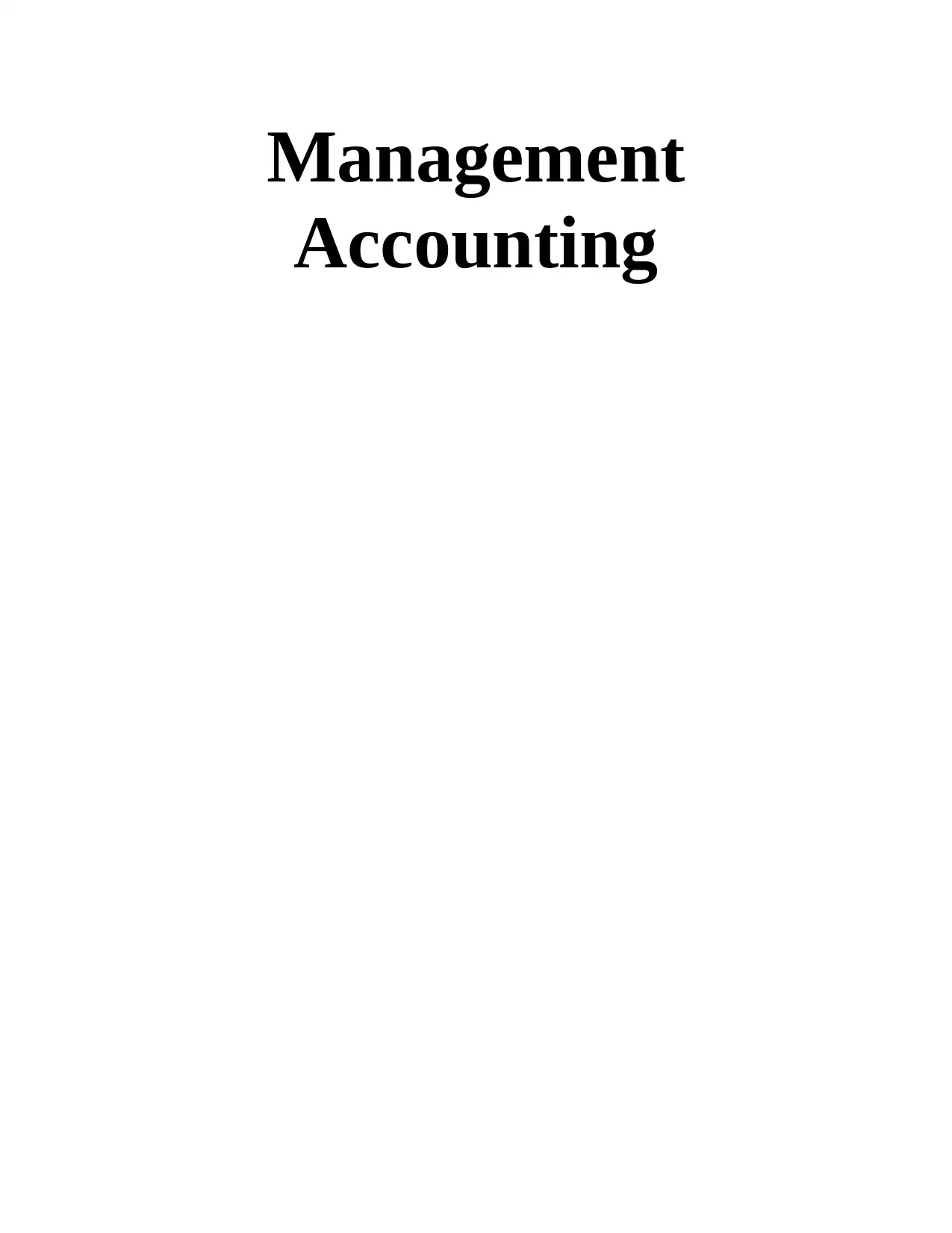
Management
Accounting
Accounting
Paraphrase This Document
Need a fresh take? Get an instant paraphrase of this document with our AI Paraphraser
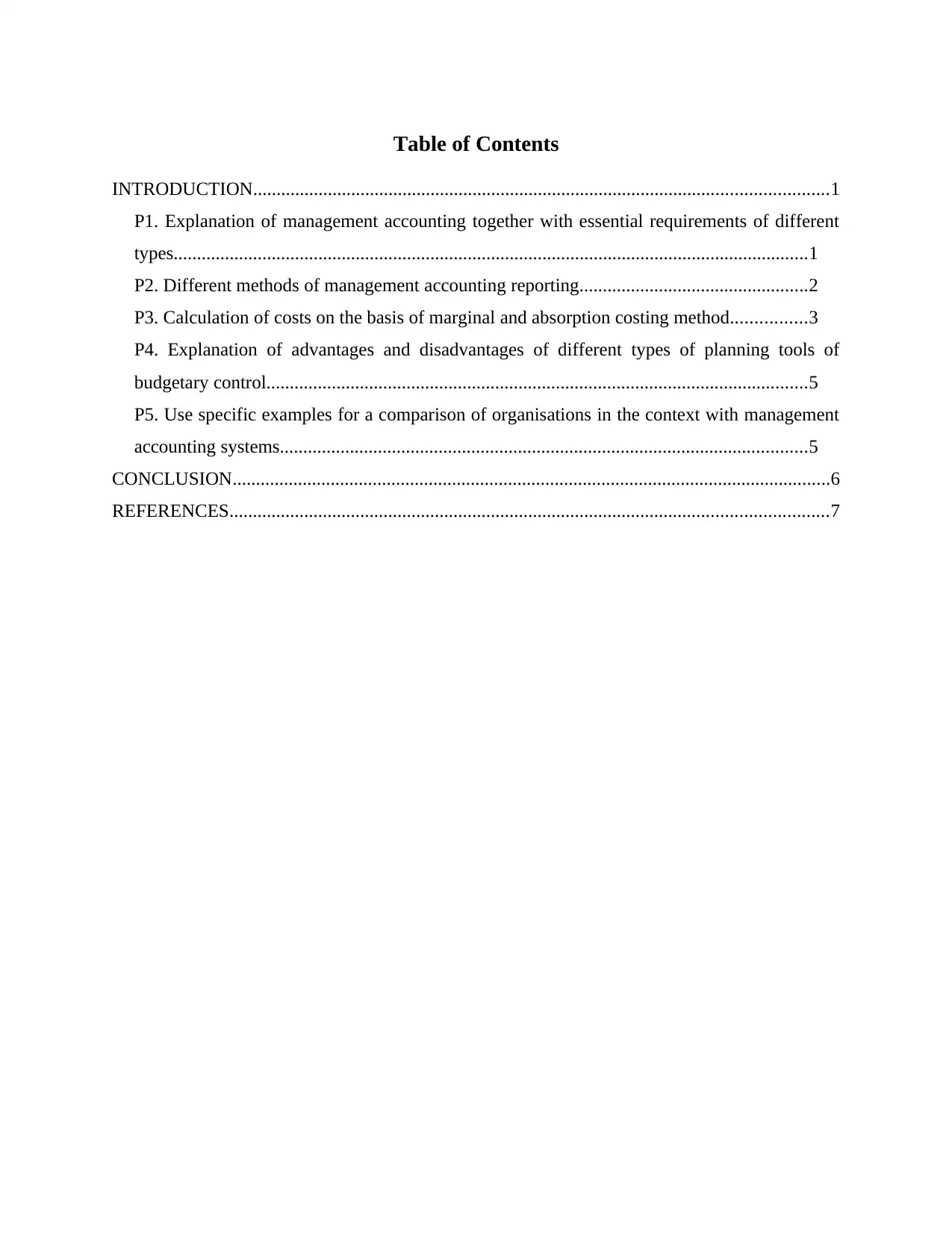
Table of Contents
INTRODUCTION...........................................................................................................................1
P1. Explanation of management accounting together with essential requirements of different
types........................................................................................................................................1
P2. Different methods of management accounting reporting.................................................2
P3. Calculation of costs on the basis of marginal and absorption costing method................3
P4. Explanation of advantages and disadvantages of different types of planning tools of
budgetary control....................................................................................................................5
P5. Use specific examples for a comparison of organisations in the context with management
accounting systems.................................................................................................................5
CONCLUSION................................................................................................................................6
REFERENCES................................................................................................................................7
INTRODUCTION...........................................................................................................................1
P1. Explanation of management accounting together with essential requirements of different
types........................................................................................................................................1
P2. Different methods of management accounting reporting.................................................2
P3. Calculation of costs on the basis of marginal and absorption costing method................3
P4. Explanation of advantages and disadvantages of different types of planning tools of
budgetary control....................................................................................................................5
P5. Use specific examples for a comparison of organisations in the context with management
accounting systems.................................................................................................................5
CONCLUSION................................................................................................................................6
REFERENCES................................................................................................................................7
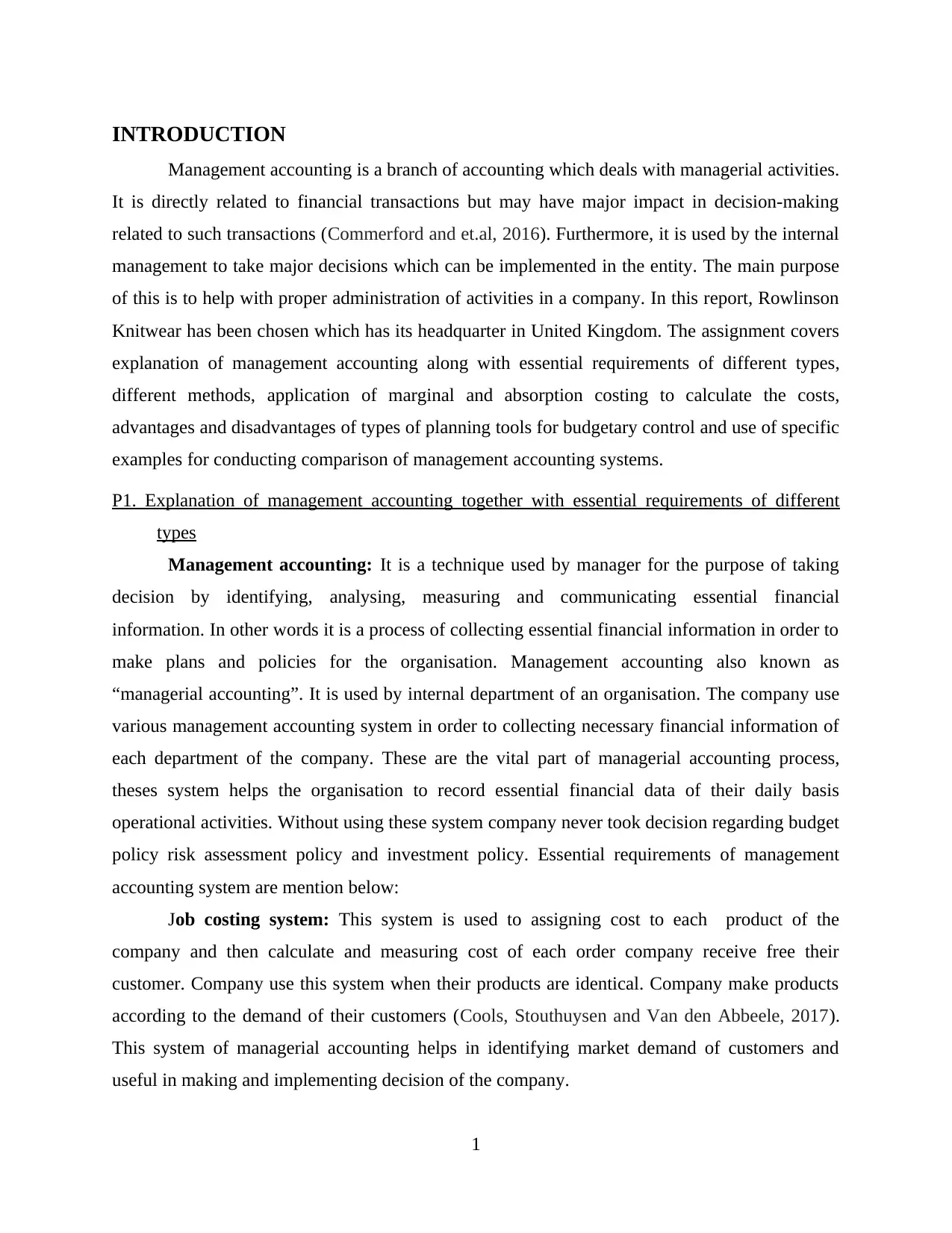
INTRODUCTION
Management accounting is a branch of accounting which deals with managerial activities.
It is directly related to financial transactions but may have major impact in decision-making
related to such transactions (Commerford and et.al, 2016). Furthermore, it is used by the internal
management to take major decisions which can be implemented in the entity. The main purpose
of this is to help with proper administration of activities in a company. In this report, Rowlinson
Knitwear has been chosen which has its headquarter in United Kingdom. The assignment covers
explanation of management accounting along with essential requirements of different types,
different methods, application of marginal and absorption costing to calculate the costs,
advantages and disadvantages of types of planning tools for budgetary control and use of specific
examples for conducting comparison of management accounting systems.
P1. Explanation of management accounting together with essential requirements of different
types
Management accounting: It is a technique used by manager for the purpose of taking
decision by identifying, analysing, measuring and communicating essential financial
information. In other words it is a process of collecting essential financial information in order to
make plans and policies for the organisation. Management accounting also known as
“managerial accounting”. It is used by internal department of an organisation. The company use
various management accounting system in order to collecting necessary financial information of
each department of the company. These are the vital part of managerial accounting process,
theses system helps the organisation to record essential financial data of their daily basis
operational activities. Without using these system company never took decision regarding budget
policy risk assessment policy and investment policy. Essential requirements of management
accounting system are mention below:
Job costing system: This system is used to assigning cost to each product of the
company and then calculate and measuring cost of each order company receive free their
customer. Company use this system when their products are identical. Company make products
according to the demand of their customers (Cools, Stouthuysen and Van den Abbeele, 2017).
This system of managerial accounting helps in identifying market demand of customers and
useful in making and implementing decision of the company.
1
Management accounting is a branch of accounting which deals with managerial activities.
It is directly related to financial transactions but may have major impact in decision-making
related to such transactions (Commerford and et.al, 2016). Furthermore, it is used by the internal
management to take major decisions which can be implemented in the entity. The main purpose
of this is to help with proper administration of activities in a company. In this report, Rowlinson
Knitwear has been chosen which has its headquarter in United Kingdom. The assignment covers
explanation of management accounting along with essential requirements of different types,
different methods, application of marginal and absorption costing to calculate the costs,
advantages and disadvantages of types of planning tools for budgetary control and use of specific
examples for conducting comparison of management accounting systems.
P1. Explanation of management accounting together with essential requirements of different
types
Management accounting: It is a technique used by manager for the purpose of taking
decision by identifying, analysing, measuring and communicating essential financial
information. In other words it is a process of collecting essential financial information in order to
make plans and policies for the organisation. Management accounting also known as
“managerial accounting”. It is used by internal department of an organisation. The company use
various management accounting system in order to collecting necessary financial information of
each department of the company. These are the vital part of managerial accounting process,
theses system helps the organisation to record essential financial data of their daily basis
operational activities. Without using these system company never took decision regarding budget
policy risk assessment policy and investment policy. Essential requirements of management
accounting system are mention below:
Job costing system: This system is used to assigning cost to each product of the
company and then calculate and measuring cost of each order company receive free their
customer. Company use this system when their products are identical. Company make products
according to the demand of their customers (Cools, Stouthuysen and Van den Abbeele, 2017).
This system of managerial accounting helps in identifying market demand of customers and
useful in making and implementing decision of the company.
1
⊘ This is a preview!⊘
Do you want full access?
Subscribe today to unlock all pages.

Trusted by 1+ million students worldwide
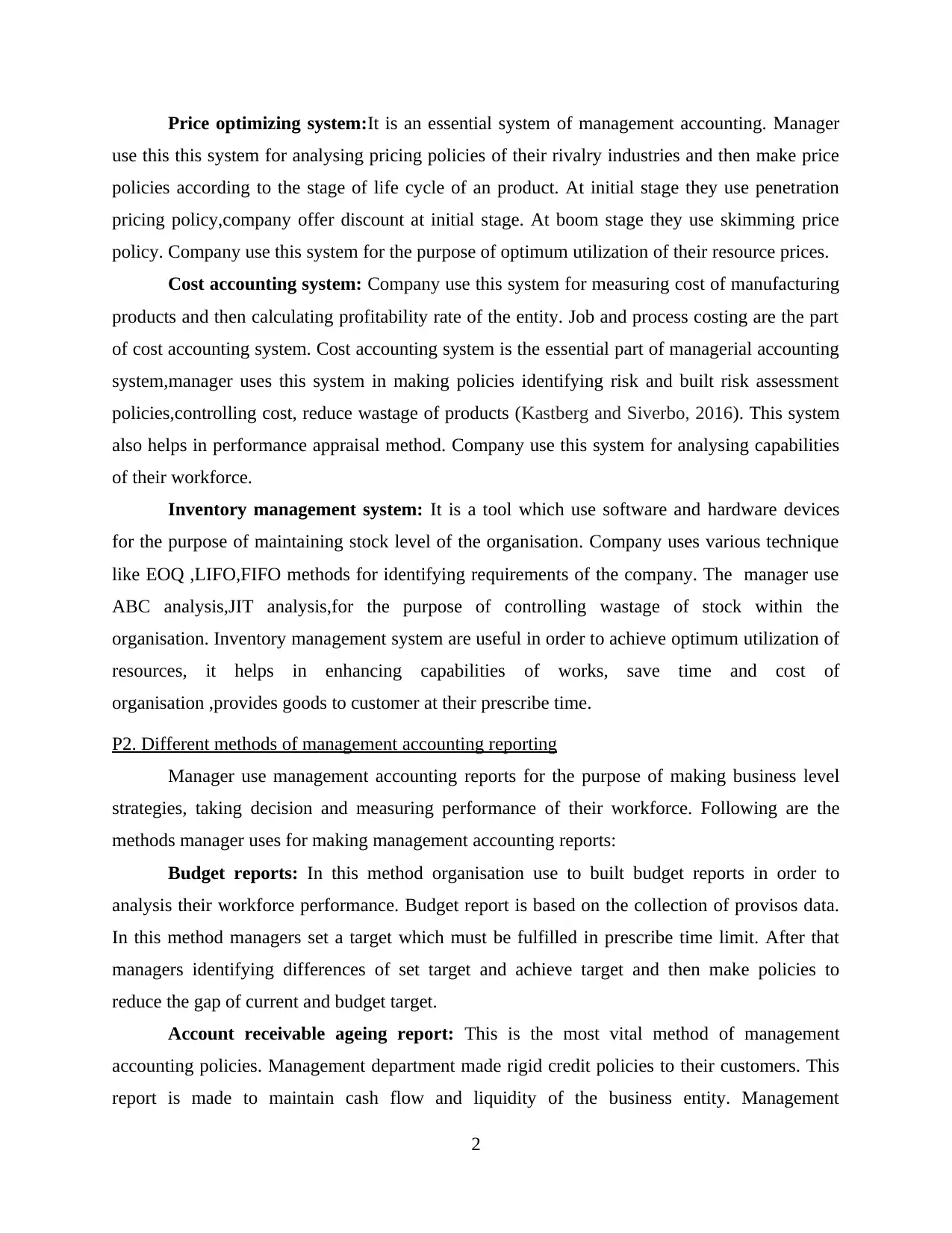
Price optimizing system:It is an essential system of management accounting. Manager
use this this system for analysing pricing policies of their rivalry industries and then make price
policies according to the stage of life cycle of an product. At initial stage they use penetration
pricing policy,company offer discount at initial stage. At boom stage they use skimming price
policy. Company use this system for the purpose of optimum utilization of their resource prices.
Cost accounting system: Company use this system for measuring cost of manufacturing
products and then calculating profitability rate of the entity. Job and process costing are the part
of cost accounting system. Cost accounting system is the essential part of managerial accounting
system,manager uses this system in making policies identifying risk and built risk assessment
policies,controlling cost, reduce wastage of products (Kastberg and Siverbo, 2016). This system
also helps in performance appraisal method. Company use this system for analysing capabilities
of their workforce.
Inventory management system: It is a tool which use software and hardware devices
for the purpose of maintaining stock level of the organisation. Company uses various technique
like EOQ ,LIFO,FIFO methods for identifying requirements of the company. The manager use
ABC analysis,JIT analysis,for the purpose of controlling wastage of stock within the
organisation. Inventory management system are useful in order to achieve optimum utilization of
resources, it helps in enhancing capabilities of works, save time and cost of
organisation ,provides goods to customer at their prescribe time.
P2. Different methods of management accounting reporting
Manager use management accounting reports for the purpose of making business level
strategies, taking decision and measuring performance of their workforce. Following are the
methods manager uses for making management accounting reports:
Budget reports: In this method organisation use to built budget reports in order to
analysis their workforce performance. Budget report is based on the collection of provisos data.
In this method managers set a target which must be fulfilled in prescribe time limit. After that
managers identifying differences of set target and achieve target and then make policies to
reduce the gap of current and budget target.
Account receivable ageing report: This is the most vital method of management
accounting policies. Management department made rigid credit policies to their customers. This
report is made to maintain cash flow and liquidity of the business entity. Management
2
use this this system for analysing pricing policies of their rivalry industries and then make price
policies according to the stage of life cycle of an product. At initial stage they use penetration
pricing policy,company offer discount at initial stage. At boom stage they use skimming price
policy. Company use this system for the purpose of optimum utilization of their resource prices.
Cost accounting system: Company use this system for measuring cost of manufacturing
products and then calculating profitability rate of the entity. Job and process costing are the part
of cost accounting system. Cost accounting system is the essential part of managerial accounting
system,manager uses this system in making policies identifying risk and built risk assessment
policies,controlling cost, reduce wastage of products (Kastberg and Siverbo, 2016). This system
also helps in performance appraisal method. Company use this system for analysing capabilities
of their workforce.
Inventory management system: It is a tool which use software and hardware devices
for the purpose of maintaining stock level of the organisation. Company uses various technique
like EOQ ,LIFO,FIFO methods for identifying requirements of the company. The manager use
ABC analysis,JIT analysis,for the purpose of controlling wastage of stock within the
organisation. Inventory management system are useful in order to achieve optimum utilization of
resources, it helps in enhancing capabilities of works, save time and cost of
organisation ,provides goods to customer at their prescribe time.
P2. Different methods of management accounting reporting
Manager use management accounting reports for the purpose of making business level
strategies, taking decision and measuring performance of their workforce. Following are the
methods manager uses for making management accounting reports:
Budget reports: In this method organisation use to built budget reports in order to
analysis their workforce performance. Budget report is based on the collection of provisos data.
In this method managers set a target which must be fulfilled in prescribe time limit. After that
managers identifying differences of set target and achieve target and then make policies to
reduce the gap of current and budget target.
Account receivable ageing report: This is the most vital method of management
accounting policies. Management department made rigid credit policies to their customers. This
report is made to maintain cash flow and liquidity of the business entity. Management
2
Paraphrase This Document
Need a fresh take? Get an instant paraphrase of this document with our AI Paraphraser
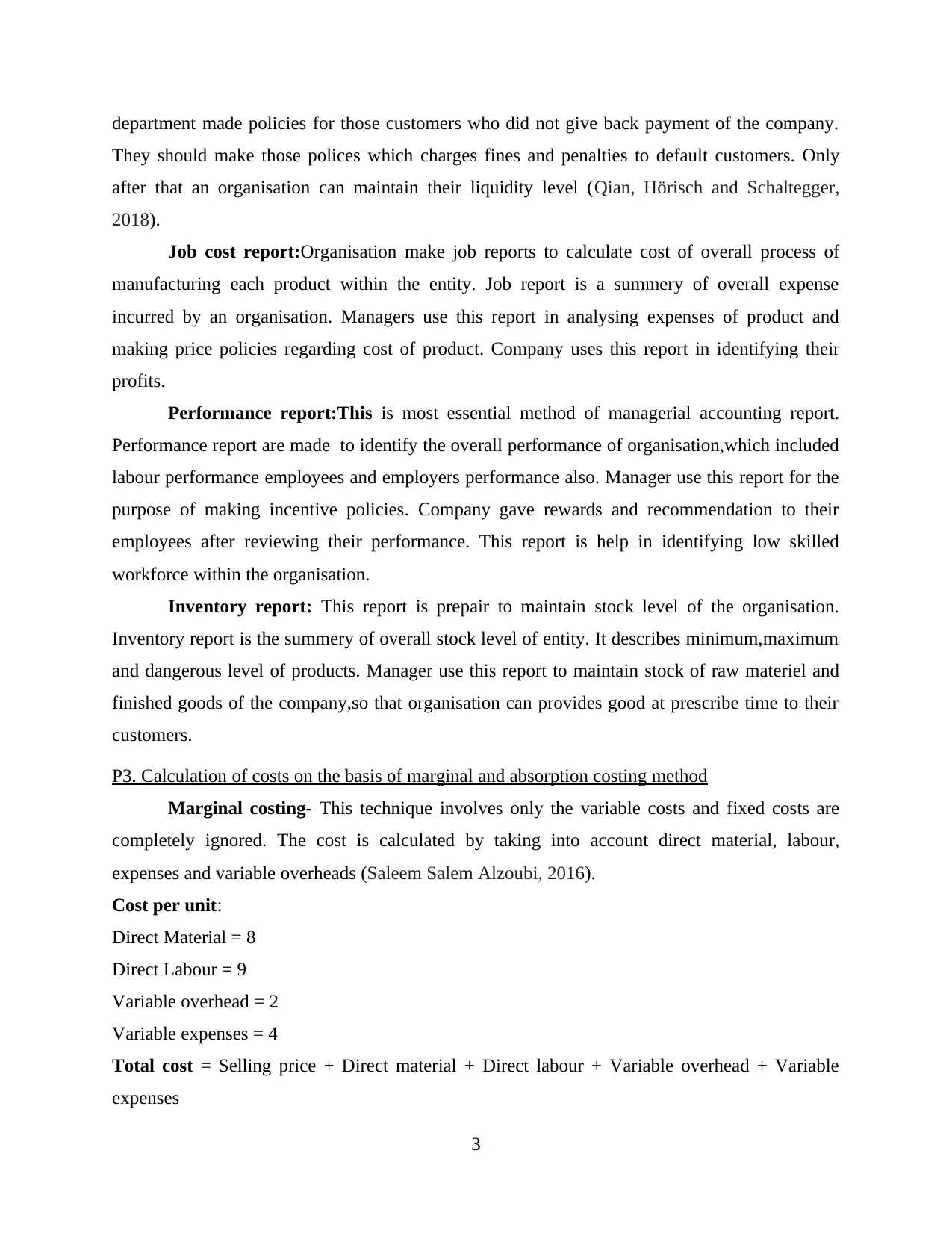
department made policies for those customers who did not give back payment of the company.
They should make those polices which charges fines and penalties to default customers. Only
after that an organisation can maintain their liquidity level (Qian, Hörisch and Schaltegger,
2018).
Job cost report:Organisation make job reports to calculate cost of overall process of
manufacturing each product within the entity. Job report is a summery of overall expense
incurred by an organisation. Managers use this report in analysing expenses of product and
making price policies regarding cost of product. Company uses this report in identifying their
profits.
Performance report:This is most essential method of managerial accounting report.
Performance report are made to identify the overall performance of organisation,which included
labour performance employees and employers performance also. Manager use this report for the
purpose of making incentive policies. Company gave rewards and recommendation to their
employees after reviewing their performance. This report is help in identifying low skilled
workforce within the organisation.
Inventory report: This report is prepair to maintain stock level of the organisation.
Inventory report is the summery of overall stock level of entity. It describes minimum,maximum
and dangerous level of products. Manager use this report to maintain stock of raw materiel and
finished goods of the company,so that organisation can provides good at prescribe time to their
customers.
P3. Calculation of costs on the basis of marginal and absorption costing method
Marginal costing- This technique involves only the variable costs and fixed costs are
completely ignored. The cost is calculated by taking into account direct material, labour,
expenses and variable overheads (Saleem Salem Alzoubi, 2016).
Cost per unit:
Direct Material = 8
Direct Labour = 9
Variable overhead = 2
Variable expenses = 4
Total cost = Selling price + Direct material + Direct labour + Variable overhead + Variable
expenses
3
They should make those polices which charges fines and penalties to default customers. Only
after that an organisation can maintain their liquidity level (Qian, Hörisch and Schaltegger,
2018).
Job cost report:Organisation make job reports to calculate cost of overall process of
manufacturing each product within the entity. Job report is a summery of overall expense
incurred by an organisation. Managers use this report in analysing expenses of product and
making price policies regarding cost of product. Company uses this report in identifying their
profits.
Performance report:This is most essential method of managerial accounting report.
Performance report are made to identify the overall performance of organisation,which included
labour performance employees and employers performance also. Manager use this report for the
purpose of making incentive policies. Company gave rewards and recommendation to their
employees after reviewing their performance. This report is help in identifying low skilled
workforce within the organisation.
Inventory report: This report is prepair to maintain stock level of the organisation.
Inventory report is the summery of overall stock level of entity. It describes minimum,maximum
and dangerous level of products. Manager use this report to maintain stock of raw materiel and
finished goods of the company,so that organisation can provides good at prescribe time to their
customers.
P3. Calculation of costs on the basis of marginal and absorption costing method
Marginal costing- This technique involves only the variable costs and fixed costs are
completely ignored. The cost is calculated by taking into account direct material, labour,
expenses and variable overheads (Saleem Salem Alzoubi, 2016).
Cost per unit:
Direct Material = 8
Direct Labour = 9
Variable overhead = 2
Variable expenses = 4
Total cost = Selling price + Direct material + Direct labour + Variable overhead + Variable
expenses
3
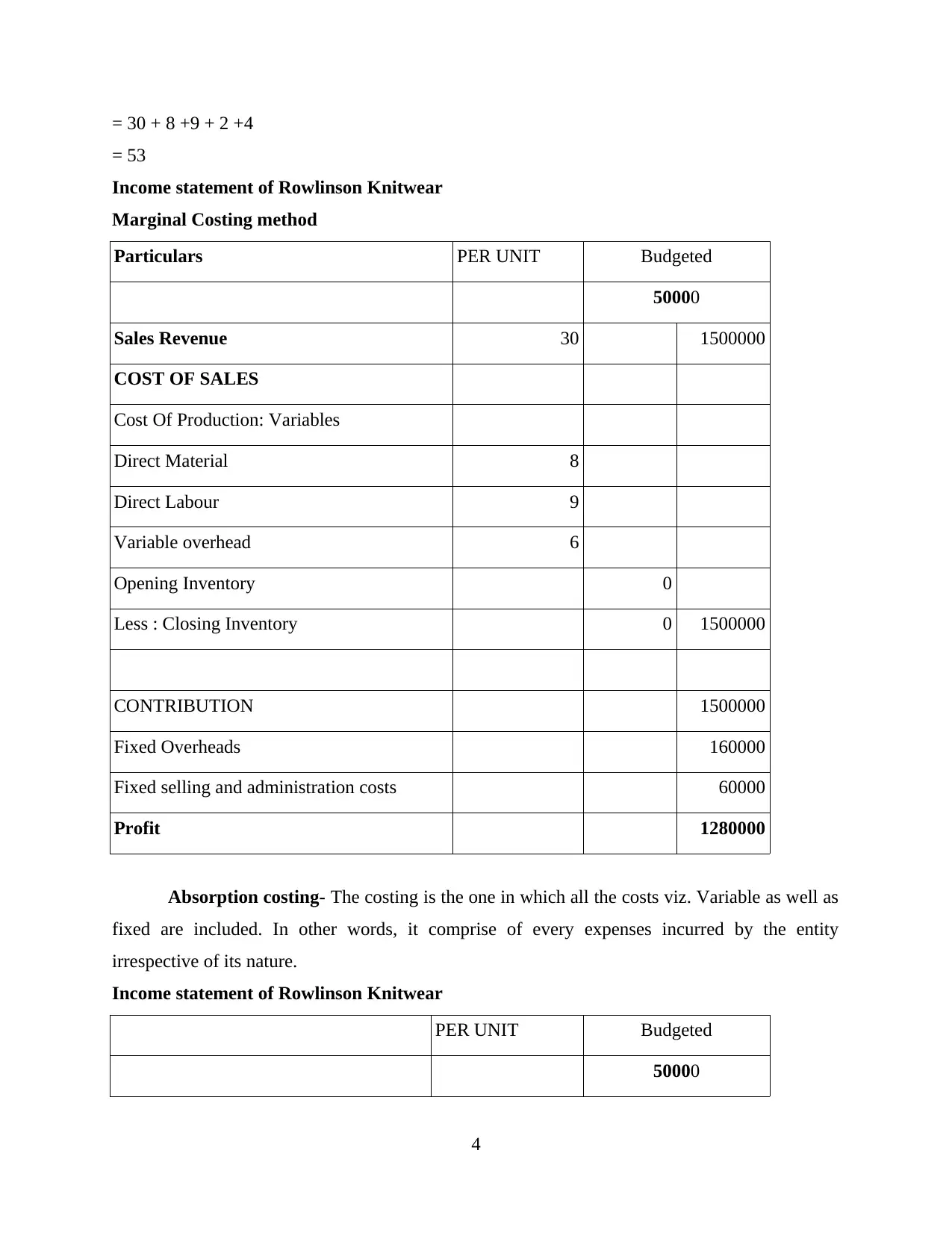
= 30 + 8 +9 + 2 +4
= 53
Income statement of Rowlinson Knitwear
Marginal Costing method
Particulars PER UNIT Budgeted
50000
Sales Revenue 30 1500000
COST OF SALES
Cost Of Production: Variables
Direct Material 8
Direct Labour 9
Variable overhead 6
Opening Inventory 0
Less : Closing Inventory 0 1500000
CONTRIBUTION 1500000
Fixed Overheads 160000
Fixed selling and administration costs 60000
Profit 1280000
Absorption costing- The costing is the one in which all the costs viz. Variable as well as
fixed are included. In other words, it comprise of every expenses incurred by the entity
irrespective of its nature.
Income statement of Rowlinson Knitwear
PER UNIT Budgeted
50000
4
= 53
Income statement of Rowlinson Knitwear
Marginal Costing method
Particulars PER UNIT Budgeted
50000
Sales Revenue 30 1500000
COST OF SALES
Cost Of Production: Variables
Direct Material 8
Direct Labour 9
Variable overhead 6
Opening Inventory 0
Less : Closing Inventory 0 1500000
CONTRIBUTION 1500000
Fixed Overheads 160000
Fixed selling and administration costs 60000
Profit 1280000
Absorption costing- The costing is the one in which all the costs viz. Variable as well as
fixed are included. In other words, it comprise of every expenses incurred by the entity
irrespective of its nature.
Income statement of Rowlinson Knitwear
PER UNIT Budgeted
50000
4
⊘ This is a preview!⊘
Do you want full access?
Subscribe today to unlock all pages.

Trusted by 1+ million students worldwide
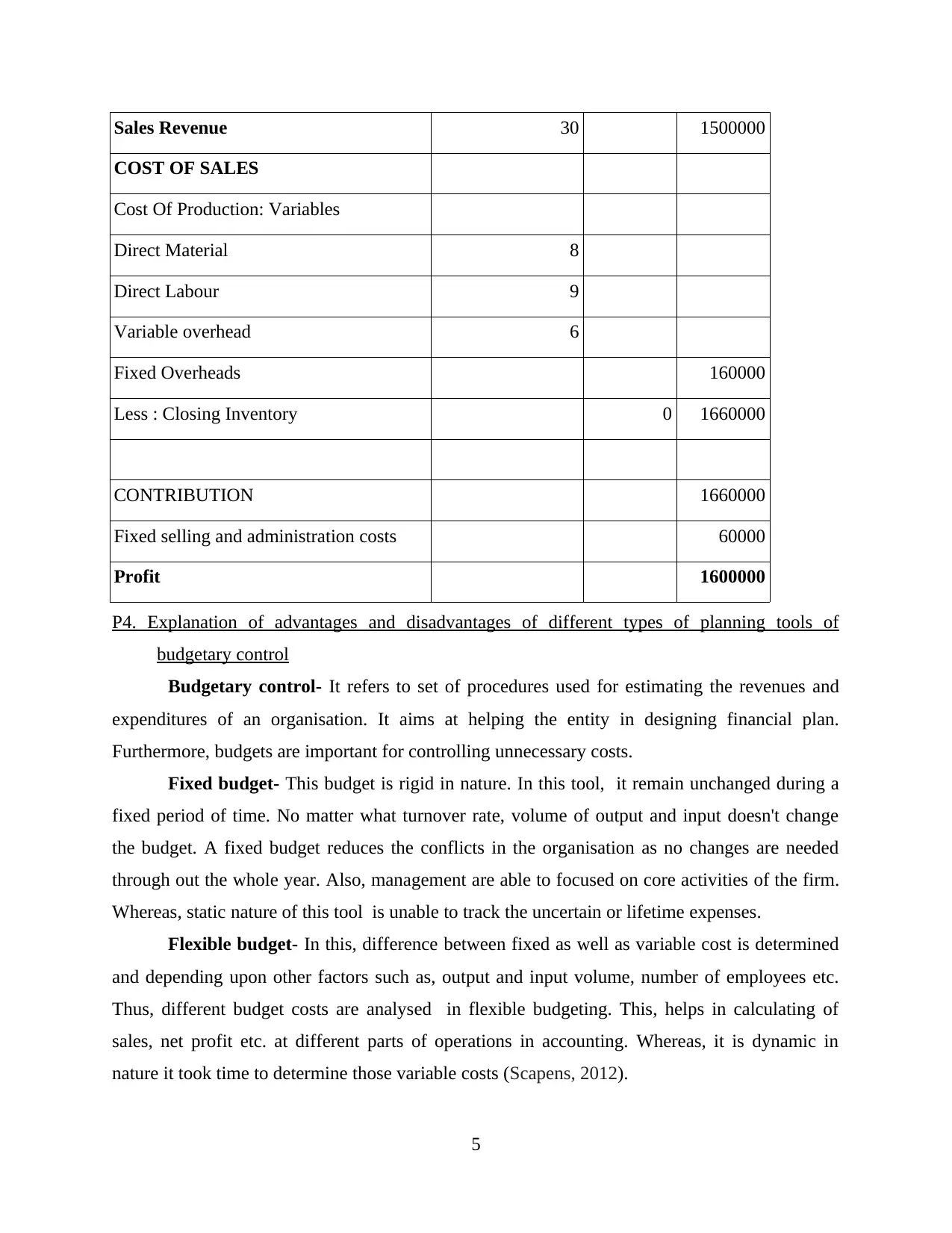
Sales Revenue 30 1500000
COST OF SALES
Cost Of Production: Variables
Direct Material 8
Direct Labour 9
Variable overhead 6
Fixed Overheads 160000
Less : Closing Inventory 0 1660000
CONTRIBUTION 1660000
Fixed selling and administration costs 60000
Profit 1600000
P4. Explanation of advantages and disadvantages of different types of planning tools of
budgetary control
Budgetary control- It refers to set of procedures used for estimating the revenues and
expenditures of an organisation. It aims at helping the entity in designing financial plan.
Furthermore, budgets are important for controlling unnecessary costs.
Fixed budget- This budget is rigid in nature. In this tool, it remain unchanged during a
fixed period of time. No matter what turnover rate, volume of output and input doesn't change
the budget. A fixed budget reduces the conflicts in the organisation as no changes are needed
through out the whole year. Also, management are able to focused on core activities of the firm.
Whereas, static nature of this tool is unable to track the uncertain or lifetime expenses.
Flexible budget- In this, difference between fixed as well as variable cost is determined
and depending upon other factors such as, output and input volume, number of employees etc.
Thus, different budget costs are analysed in flexible budgeting. This, helps in calculating of
sales, net profit etc. at different parts of operations in accounting. Whereas, it is dynamic in
nature it took time to determine those variable costs (Scapens, 2012).
5
COST OF SALES
Cost Of Production: Variables
Direct Material 8
Direct Labour 9
Variable overhead 6
Fixed Overheads 160000
Less : Closing Inventory 0 1660000
CONTRIBUTION 1660000
Fixed selling and administration costs 60000
Profit 1600000
P4. Explanation of advantages and disadvantages of different types of planning tools of
budgetary control
Budgetary control- It refers to set of procedures used for estimating the revenues and
expenditures of an organisation. It aims at helping the entity in designing financial plan.
Furthermore, budgets are important for controlling unnecessary costs.
Fixed budget- This budget is rigid in nature. In this tool, it remain unchanged during a
fixed period of time. No matter what turnover rate, volume of output and input doesn't change
the budget. A fixed budget reduces the conflicts in the organisation as no changes are needed
through out the whole year. Also, management are able to focused on core activities of the firm.
Whereas, static nature of this tool is unable to track the uncertain or lifetime expenses.
Flexible budget- In this, difference between fixed as well as variable cost is determined
and depending upon other factors such as, output and input volume, number of employees etc.
Thus, different budget costs are analysed in flexible budgeting. This, helps in calculating of
sales, net profit etc. at different parts of operations in accounting. Whereas, it is dynamic in
nature it took time to determine those variable costs (Scapens, 2012).
5
Paraphrase This Document
Need a fresh take? Get an instant paraphrase of this document with our AI Paraphraser
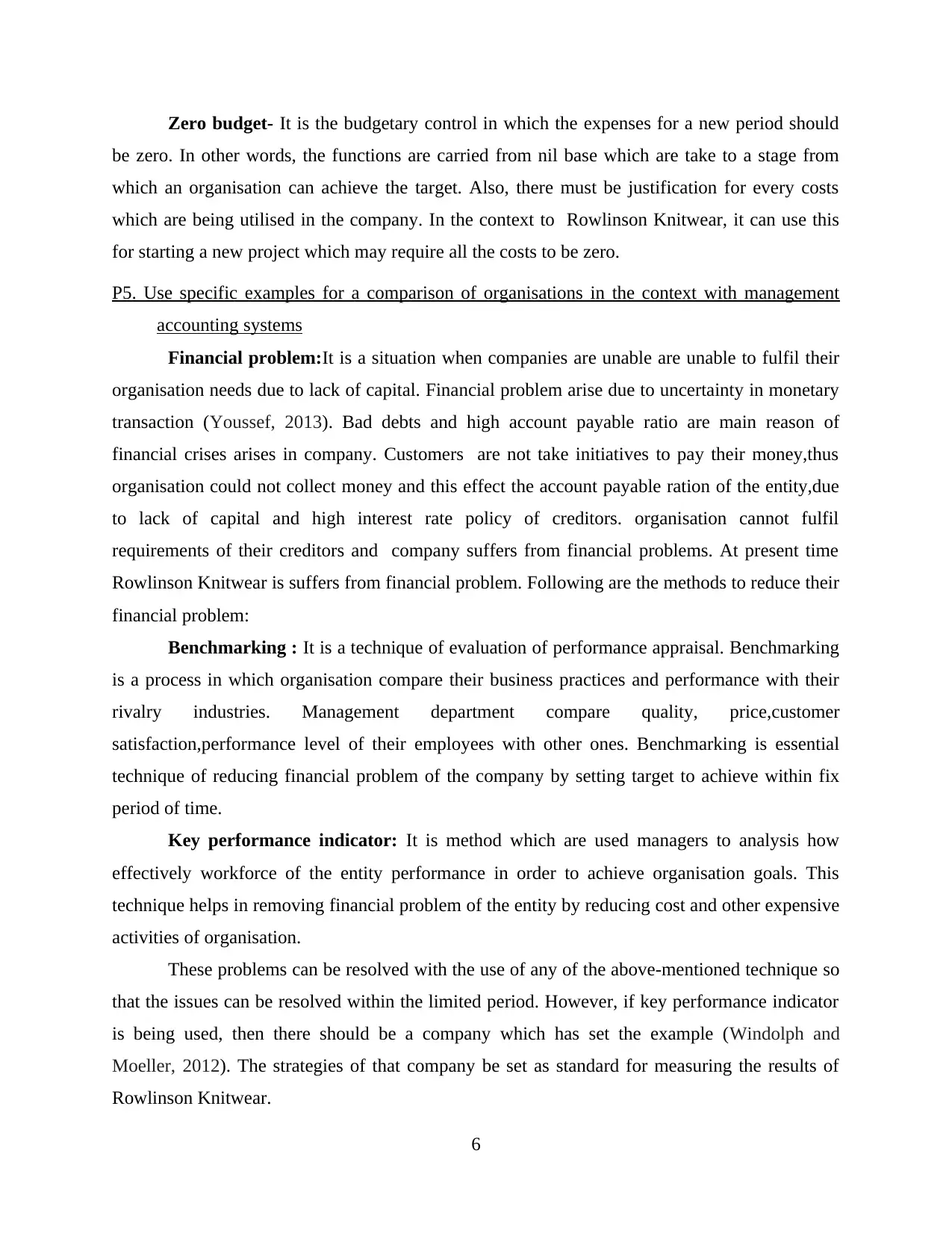
Zero budget- It is the budgetary control in which the expenses for a new period should
be zero. In other words, the functions are carried from nil base which are take to a stage from
which an organisation can achieve the target. Also, there must be justification for every costs
which are being utilised in the company. In the context to Rowlinson Knitwear, it can use this
for starting a new project which may require all the costs to be zero.
P5. Use specific examples for a comparison of organisations in the context with management
accounting systems
Financial problem:It is a situation when companies are unable are unable to fulfil their
organisation needs due to lack of capital. Financial problem arise due to uncertainty in monetary
transaction (Youssef, 2013). Bad debts and high account payable ratio are main reason of
financial crises arises in company. Customers are not take initiatives to pay their money,thus
organisation could not collect money and this effect the account payable ration of the entity,due
to lack of capital and high interest rate policy of creditors. organisation cannot fulfil
requirements of their creditors and company suffers from financial problems. At present time
Rowlinson Knitwear is suffers from financial problem. Following are the methods to reduce their
financial problem:
Benchmarking : It is a technique of evaluation of performance appraisal. Benchmarking
is a process in which organisation compare their business practices and performance with their
rivalry industries. Management department compare quality, price,customer
satisfaction,performance level of their employees with other ones. Benchmarking is essential
technique of reducing financial problem of the company by setting target to achieve within fix
period of time.
Key performance indicator: It is method which are used managers to analysis how
effectively workforce of the entity performance in order to achieve organisation goals. This
technique helps in removing financial problem of the entity by reducing cost and other expensive
activities of organisation.
These problems can be resolved with the use of any of the above-mentioned technique so
that the issues can be resolved within the limited period. However, if key performance indicator
is being used, then there should be a company which has set the example (Windolph and
Moeller, 2012). The strategies of that company be set as standard for measuring the results of
Rowlinson Knitwear.
6
be zero. In other words, the functions are carried from nil base which are take to a stage from
which an organisation can achieve the target. Also, there must be justification for every costs
which are being utilised in the company. In the context to Rowlinson Knitwear, it can use this
for starting a new project which may require all the costs to be zero.
P5. Use specific examples for a comparison of organisations in the context with management
accounting systems
Financial problem:It is a situation when companies are unable are unable to fulfil their
organisation needs due to lack of capital. Financial problem arise due to uncertainty in monetary
transaction (Youssef, 2013). Bad debts and high account payable ratio are main reason of
financial crises arises in company. Customers are not take initiatives to pay their money,thus
organisation could not collect money and this effect the account payable ration of the entity,due
to lack of capital and high interest rate policy of creditors. organisation cannot fulfil
requirements of their creditors and company suffers from financial problems. At present time
Rowlinson Knitwear is suffers from financial problem. Following are the methods to reduce their
financial problem:
Benchmarking : It is a technique of evaluation of performance appraisal. Benchmarking
is a process in which organisation compare their business practices and performance with their
rivalry industries. Management department compare quality, price,customer
satisfaction,performance level of their employees with other ones. Benchmarking is essential
technique of reducing financial problem of the company by setting target to achieve within fix
period of time.
Key performance indicator: It is method which are used managers to analysis how
effectively workforce of the entity performance in order to achieve organisation goals. This
technique helps in removing financial problem of the entity by reducing cost and other expensive
activities of organisation.
These problems can be resolved with the use of any of the above-mentioned technique so
that the issues can be resolved within the limited period. However, if key performance indicator
is being used, then there should be a company which has set the example (Windolph and
Moeller, 2012). The strategies of that company be set as standard for measuring the results of
Rowlinson Knitwear.
6
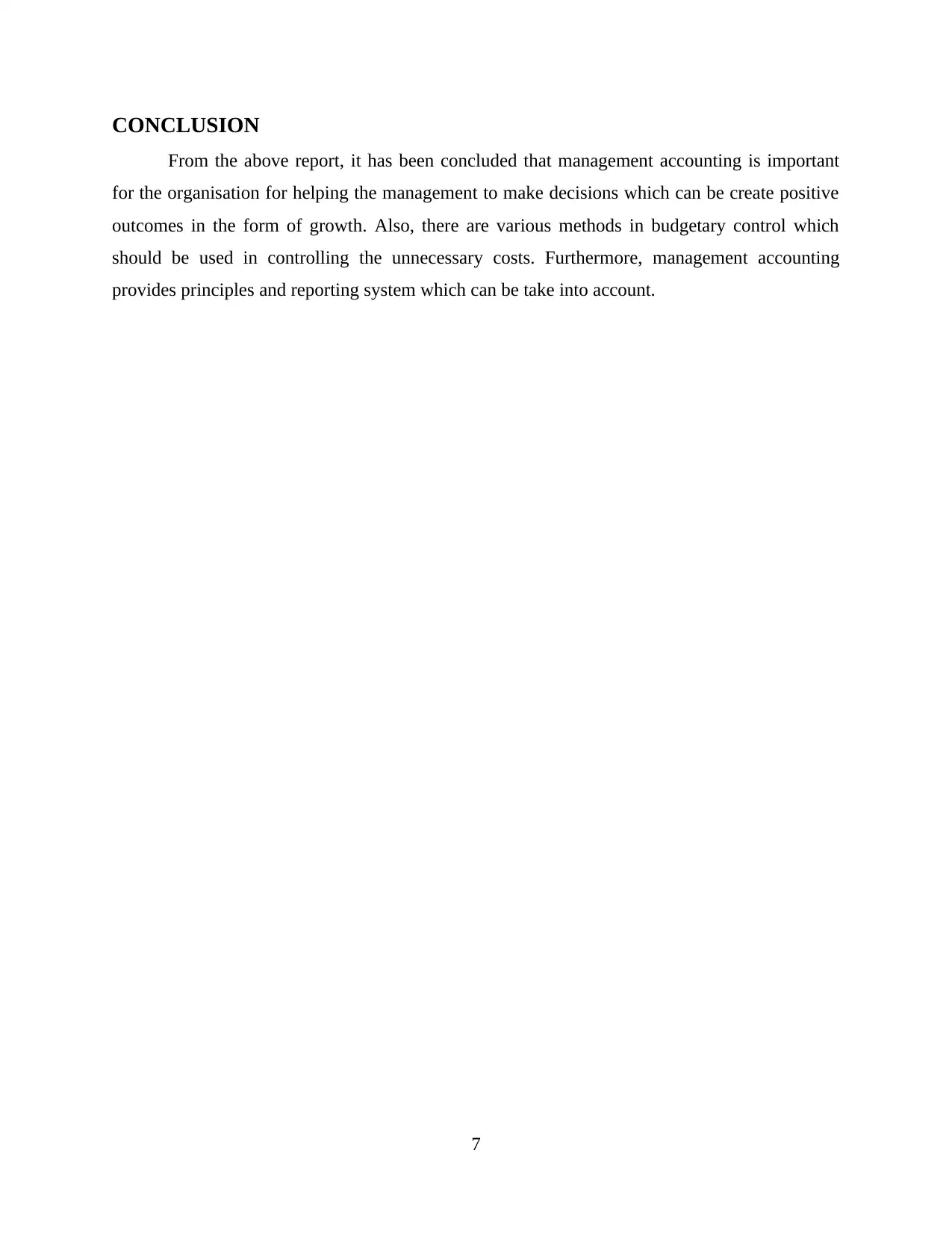
CONCLUSION
From the above report, it has been concluded that management accounting is important
for the organisation for helping the management to make decisions which can be create positive
outcomes in the form of growth. Also, there are various methods in budgetary control which
should be used in controlling the unnecessary costs. Furthermore, management accounting
provides principles and reporting system which can be take into account.
7
From the above report, it has been concluded that management accounting is important
for the organisation for helping the management to make decisions which can be create positive
outcomes in the form of growth. Also, there are various methods in budgetary control which
should be used in controlling the unnecessary costs. Furthermore, management accounting
provides principles and reporting system which can be take into account.
7
⊘ This is a preview!⊘
Do you want full access?
Subscribe today to unlock all pages.

Trusted by 1+ million students worldwide
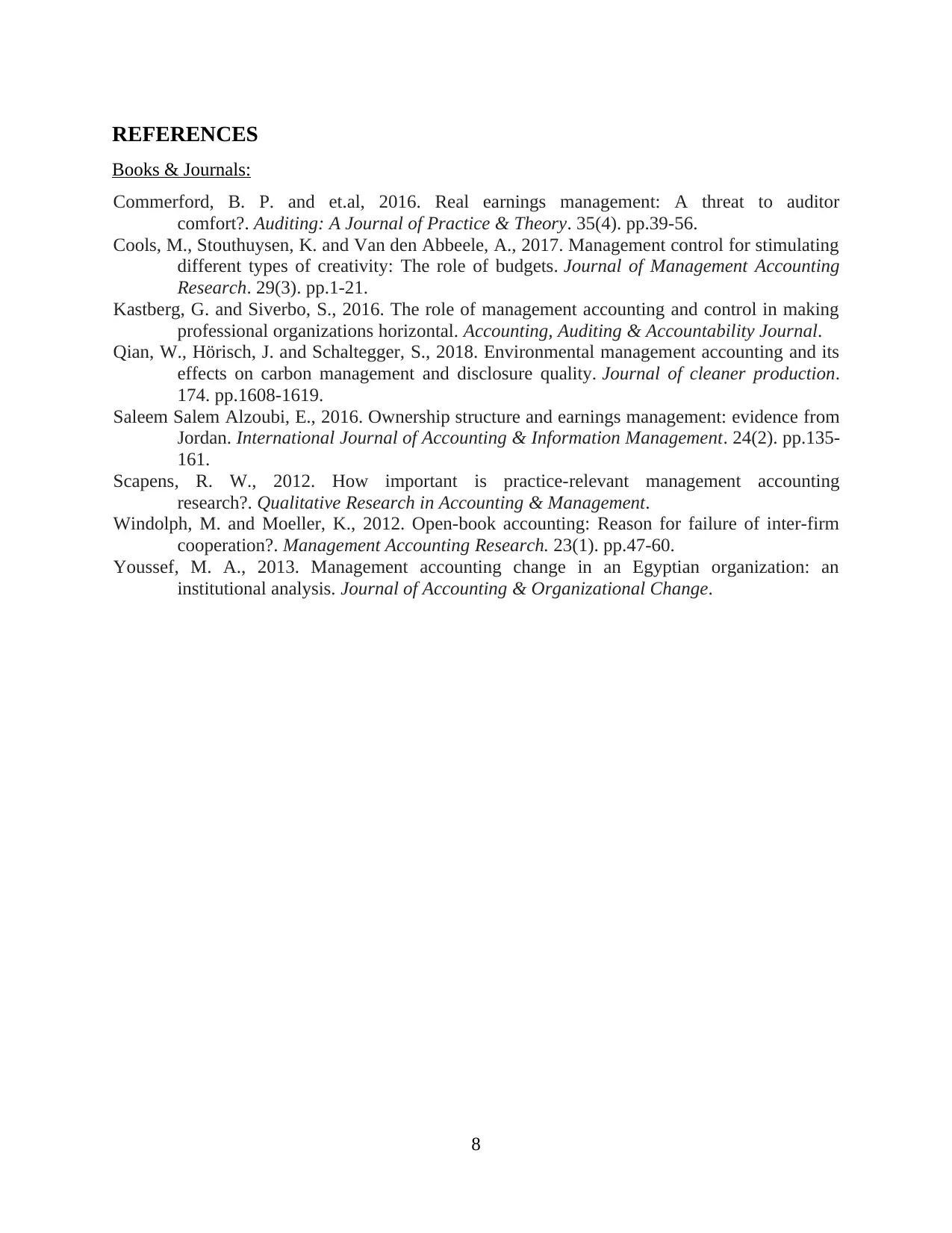
REFERENCES
Books & Journals:
Commerford, B. P. and et.al, 2016. Real earnings management: A threat to auditor
comfort?. Auditing: A Journal of Practice & Theory. 35(4). pp.39-56.
Cools, M., Stouthuysen, K. and Van den Abbeele, A., 2017. Management control for stimulating
different types of creativity: The role of budgets. Journal of Management Accounting
Research. 29(3). pp.1-21.
Kastberg, G. and Siverbo, S., 2016. The role of management accounting and control in making
professional organizations horizontal. Accounting, Auditing & Accountability Journal.
Qian, W., Hörisch, J. and Schaltegger, S., 2018. Environmental management accounting and its
effects on carbon management and disclosure quality. Journal of cleaner production.
174. pp.1608-1619.
Saleem Salem Alzoubi, E., 2016. Ownership structure and earnings management: evidence from
Jordan. International Journal of Accounting & Information Management. 24(2). pp.135-
161.
Scapens, R. W., 2012. How important is practice-relevant management accounting
research?. Qualitative Research in Accounting & Management.
Windolph, M. and Moeller, K., 2012. Open-book accounting: Reason for failure of inter-firm
cooperation?. Management Accounting Research. 23(1). pp.47-60.
Youssef, M. A., 2013. Management accounting change in an Egyptian organization: an
institutional analysis. Journal of Accounting & Organizational Change.
8
Books & Journals:
Commerford, B. P. and et.al, 2016. Real earnings management: A threat to auditor
comfort?. Auditing: A Journal of Practice & Theory. 35(4). pp.39-56.
Cools, M., Stouthuysen, K. and Van den Abbeele, A., 2017. Management control for stimulating
different types of creativity: The role of budgets. Journal of Management Accounting
Research. 29(3). pp.1-21.
Kastberg, G. and Siverbo, S., 2016. The role of management accounting and control in making
professional organizations horizontal. Accounting, Auditing & Accountability Journal.
Qian, W., Hörisch, J. and Schaltegger, S., 2018. Environmental management accounting and its
effects on carbon management and disclosure quality. Journal of cleaner production.
174. pp.1608-1619.
Saleem Salem Alzoubi, E., 2016. Ownership structure and earnings management: evidence from
Jordan. International Journal of Accounting & Information Management. 24(2). pp.135-
161.
Scapens, R. W., 2012. How important is practice-relevant management accounting
research?. Qualitative Research in Accounting & Management.
Windolph, M. and Moeller, K., 2012. Open-book accounting: Reason for failure of inter-firm
cooperation?. Management Accounting Research. 23(1). pp.47-60.
Youssef, M. A., 2013. Management accounting change in an Egyptian organization: an
institutional analysis. Journal of Accounting & Organizational Change.
8
Paraphrase This Document
Need a fresh take? Get an instant paraphrase of this document with our AI Paraphraser

9
1 out of 11
Related Documents
Your All-in-One AI-Powered Toolkit for Academic Success.
+13062052269
info@desklib.com
Available 24*7 on WhatsApp / Email
![[object Object]](/_next/static/media/star-bottom.7253800d.svg)
Unlock your academic potential
Copyright © 2020–2025 A2Z Services. All Rights Reserved. Developed and managed by ZUCOL.





